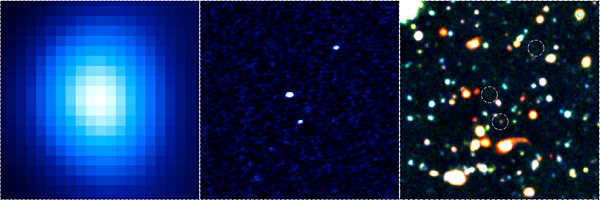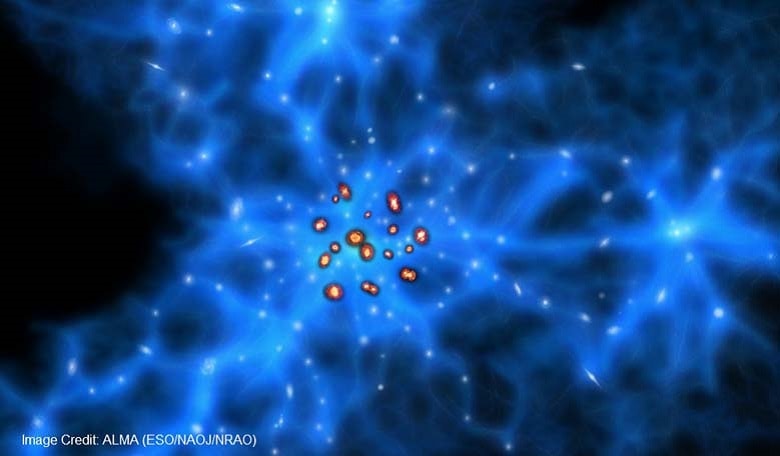Nestled in gigantic filaments in a web of dark matter, a nest of monstrous baby galaxies 11.5 billion light-years away, have been observed by a research team led by Hideki Umehata, a postdoctoral fellow of the Japan Society for the Promotion of Science staying at the European Southern Observatory, Germany, using the Atacama Large Millimetre/submillimetre array (ALMA), giving researchers a glimpse into how massive galaxies formed in the early epochs of our Universe.
It is thought that these young galaxies, that would have had star formation rates hundreds or thousands of times what we currently observe in the Milky Way, evolved into giant elliptical galaxies over time. Locating these monstrous galaxies could help researchers ascertain the role dark matter plays in galaxy formation, as it theorised that they form in environments where the substance that makes up about 27 percent of all matter and energy in the Universe, is concentrated.
Finding such gigantic galaxies should perhaps seem straight forward – they are very large after all – however such objects are often obscured in dust. The presence of dust grains along a given line of sight can often be observed by their effects upon starlight passing through them. Dust grains absorb starlight emitted by objects in the Universe and re-radiate this radiation at mid- to far-IR wavelengths. Telescopes that are sensitive to detecting this radiation typically have not had the resolution needed to pin-point individual galaxies. Now though, the dust-sensitive nature of the ALMA telescope has enabled researchers to determine the positions of these former active star forming galaxies with enough precision, that tests able to predict this theory can now be examined.
 Left image: one bright monstrous galaxy taken at sub-millimeter wavelengths with ASTE.
Left image: one bright monstrous galaxy taken at sub-millimeter wavelengths with ASTE.
Centre: with 60 times better resolution the ALMA image shows that actually there are 3 monstrous galaxies close together and not one.
Right: the same region photographed in visible light by the Subaru Telescope.
Image credit: ALMA (ESO/NAOJ/NRAO), NAOJ, H. Umehata (The University of Tokyo)
Using the much improved sensitivity and resolution of the ALMA telescopes, the team were able to make extensive observations of a small part of the sky called SSA22 in the constellation Aquarius (the Water-Bearer) to study a cluster of young galaxies 11.5 billion light-years from Earth. These images were then compared with previous observations made in visible light of the same galaxies by the Subaru Telescope, operated by the National Astronomical Observatory of Japan (NAOJ).
Observations confirmed that the young monstrous galaxies seemed to be located right at the intersection of a large filamentary structure, thought to be a huge 3D web of invisible dark matter. In the standard model of the evolution of the universe, structures such as the cosmic Great Wall, a gigantic filamentary structure spanning over 500 million light-years is thought to form along and follow web-like strings of dark matter. Does dark matter dictate the structure of the Universe? Studies such as this hope to answer that question and to establish the role monster galaxies have in relation to dark matter distribution.











